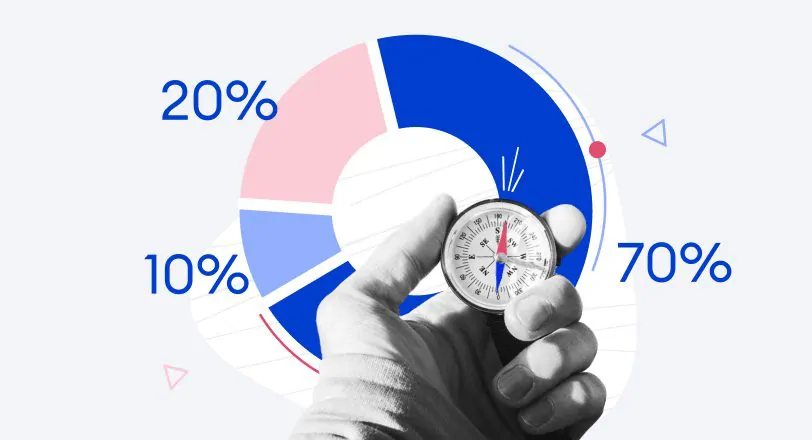How to Create an Instructional Design Portfolio that Makes You Shine

An instructional design portfolio is an important tool that allows freelance instructional designers to demonstrate their capabilities and helps them build their professional practice. If you want to do more freelance work, are looking for a job, or want to submit your work for awards, you’ll need an eye-catching online presence with samples of your work.
In this article for novice IDs looking to create their online portfolio and seasoned IDs who still don’t have a portfolio, we’ll discuss the why, what, and how of creating a great instructional design portfolio.
Why Should You Have an Instructional Design Portfolio?
There are three main reasons why you need a portfolio of your work:
Demonstrate your skills
If you are an experienced instructional designer and have been in corporate learning for a while, your mother still may not know what to tell people what you do when she has an occasion to talk about you to other people! We all know that showing is better than telling, and an online portfolio is a good example. Having your own space to show your skills is a gratifying experience to demonstrate to the world that you have contributed and move your profession to the next level.
Attract potential employers or clients
It goes without saying that an online eLearning and work portfolio is important for developing an instructional design career – it allows you to attract potential employers when coupled with your online social media presence. Having a single place for colleagues, bosses, and others to look at your work is important when sending out resumes in a job search or when tweeting about new software, development, or research elements. It shows that you have done the work and are able to comment in a credible and professional manner.
Determine your development needs
Finally, a portfolio is an excellent place to show your best work and determine where you need to develop your skills and become even more amazing! You could also set up a portfolio to determine what you’ve mastered and what you could work on in order to compare with those around you in the instructional design world. There are a huge number of instructional design portfolios online today and it’s easy to find both good and bad examples. Although comparing yourself to another person is a fruitless pursuit, learning from their example or using their portfolios as your inspiration is how all the great masters have built and honed their skills.
Examples of Good Instructional Design Portfolios
Here are some examples of different types of instructional design portfolios. Some are hosted and developed based on pre-existing templates (like Bluehost or WordPress) and some are custom-built. These are presented in no particular order, but are good examples of layout, content, and flow.
Lila Azouz has a clean portfolio that demonstrates her capabilities in a multitude of design and development tools and perspectives. The layout of the site allows you to contact her and it protects copyright via password protection on client work that cannot be publicly displayed.

Cath Ellis has given a lovely modern look and feel to her portfolio and displays her instructional design projects by technology type. She also uses easily recognizable icons and navigation that helps one feel comfortable when looking at her examples or moving around in her portfolio.

Shalini Mathias has a really interesting portfolio that was built with the Prezi presentation software! Both the outline and the presentation are available. While Prezi isn’t as popular as it once was, this is a great way to demonstrate both knowledge and skill in different types of learning technologies.

Tracy Parish is a senior instructional designer for eLearning and an Articulate master. Her portfolio is full of helpful design tips and instructions on how she achieved her samples. This is a good example of a designer not looking for a job, but highlighting skills and sharing with the community.

Bruce Richards’ portfolio is a different design altogether and is a scrolling resume/CV highlighting his experience in the learning and design fields and has a portfolio of thumbnails to explore.

A Guide for Building an Instructional Design Portfolio
The examples above are beautiful and interesting, but they did not get built in one night. You can also create a great looking portfolio, you just need to decide on a few things before you dive in and start sharing with the world.
Let’s look at the steps you’ll want to consider before you build your portfolio. Сheck out this infographic for an overview:

Step 1: Develop your brand
The first thing to consider is the content approach, or how viewers will see you and your brand with your display. This is the first thing you need to work on.
Consider why you are building this work of art and what you want it to say about yourself and your work
Take a look at your online presence from an external perspective. Build a persona for your social media presence. Is it all over the place with your personal and professional worlds mashed together? This is okay if that’s what you want. If you don’t, now is the time to consider what you want your online persona to be and start to shape your portfolio to reflect that.
Who are you building this portfolio for: employers, grad school, or potential clients? Create a persona of who that ‘person’ is (just like creating personas for the learners in your programs!) so you can position the samples in a way that viewers will find interesting and appealing.
You may want to consider several different views of your portfolio tailored to the groups that you want to attract to view your work. If you haven’t seen one before, you may want to use an empathy map. An empathy map is a picture of your client, audience, or employer. It takes an outsider’s view (a view empathetic to the situation and environment of the portfolio viewer). It makes a list of what your viewer will be exposed to in their current circumstances, what they know about ID, what their own work environment confronts them with, what they are hearing from their own bosses, clients, and employees, and other things that allow you to see your portfolio from someone else’s perspective.

Traditional empathy map
Look around! Make a collection of elements, pages, samples, layouts, etc. to inspire you
Of course, no one is advocating stealing or copying here, but many artists have used others’ works as a way of inspiring their own projects. These are often referred to as ‘mood boards’. A mood board is a collection of images, colors, layouts, writing, and navigation from all over the Internet that you feel would be representative of you, your brand, and your message.
Here’s an example:

If you’ve been working in a corporate environment with strict branding guidelines, you’ve seen examples of the company’s ‘mood board’. The collection of colors, fonts, images, layouts, and language styles, should be consistent and reflect the persona you are trying to promote (which, ultimately, should be you).
Assembling a mood board will help you identify the style and brand you want to create for yourself. Use it when looking at the templates or sites that you will choose to set up your portfolio.
Step 2. Assemble the content for your portfolio
Are you aiming to get a new job, take on new clients, or expand your professional network and reputation? To accomplish any of this, you’ll first need to consider the content you have and prepare eLearning samples to include.
Begin gathering your work
Collect all the work that you want to represent in your portfolio and categorize it.
- If you have a very large portfolio or have multiple potential types of viewers: You may want to categorize against a grid such as type of сlient vs. modality, industry vs. timeline, client vs. budget. It’s your call to determine how to make your samples super easy to use.
- If you have more offline than online samples: You can convert your face-to-face PowerPoint and workbook samples to HTML5 format if you prefer (using authoring tools like iSpring Suite), or you can post thumbnails of your work.
- If you have work that is restricted by an NDA or can’t be used due to a contract: You can still take sample slides that are representative of your work and remove identifying marks, names, or other elements. There has to be some work you’ve done that isn’t entirely restricted by an NDA. (If there isn’t, you’ll need to make some generic samples for display and mention that they represent the work you did for the employer).
- If you only contributed part of the design, writing, or coding for the project: That’s okay! You will need to tell the story of how you collaborated, what you contributed, and how it worked out. Just don’t misrepresent others’ work as your own.
Tell the story of each sample
- Each of your samples should have information relevant to your audience (remember your audience personas and write for them!) In some cases, you will want to outline your contribution, tools used, context for the development (the intended audience and time period), and outcome.
- Your samples should tell the story of how you have used a variety of ways to solve problems with design, accessibility, client management, or something that demonstrates not only your technical proficiency but also your style, your ability to manage or participate in collaborative work, and your overall professionalism.
- If you are grouping your projects by industry (e.g., healthcare, defense, and banking) consider an opening paragraph before the samples summarizing your experience in the industry, including your role titles, level of authority or influence, and overall length of time in the industry. Your potential employer in that industry will appreciate your relating to them specifically.
Step 3: Create and optimize your portfolio
Okay, so now you have to put your eLearning portfolio online. Even if you aren’t experienced with websites, hosting, or other elements of cyberspace, it’s pretty easy to navigate if you stick to platforms built for people who aren’t coders. Here is a general explanation of site types you’ll want to consider.
1. Hosted portfolio platforms
In this type of setup, the website, server (that will host your designs and eLearning samples) and everything else is done for you by a single company. The benefit of this is that they are purpose-built for portfolio use and easy to use and maintain, as they have preset templates for making a portfolio. And although these portfolio sites don’t often come with a lot of templates (especially free ones), they do give you a chance to create a portfolio with basic technical skills and no programming requirement.
Some of the most popular portfolio website builders are Behance, Dribble, and Adobe Portfolio. Keep in mind that these portfolio sites are usually for visual artists and graphic designers, so you may not be able to do more than show individual slides or images unless you pay for more storage space on the site and the widgets to show interactive pieces (like eLearning courses).

Examples of design portfolios created in Dribble
2. Website platforms (business websites)
The benefit of these types of sites, beyond just portfolio-specific sites, is that there are more types of templates (not all of them will be relevant) and widgets to add contact methods, social linking, etc. that you may find useful if you are or will consider being a freelancer. Website platforms have all the templates, hosting, storage, layout, and other widgets already built for you. You do not need to know how to write HTML code, JavaScript, or any other type of programming to get beautiful results.
Many of these sites are free if you don’t select the ‘premium’ templates. The platforms are easy to use and the most popular ones include WordPress, Weebly, and Wix. These sites have hundreds of templates and widgets for people who want to make an online entrance but aren’t programmers or media companies. Keep in mind that there is a huge difference between the .com and the .org versions of WordPress. If you don’t know how to program html, you’ll want the .com version.
Like the portfolio platforms, you will need to pay for the ability to use widgets that will host your eLearning samples and make some things interactive, like contact widgets and video spaces.
3. Self-hosted websites
If you know coding or can manage your html, building your own website will be the best solution because it helps you control all your design and data. Of course, you don’t have to start completely from scratch as there are plenty of codebases you can download and then use to help you optimize your time. Probably the site and codebase that is used most for this is WordPress. Unlike the hosted version, wordpress.org is a downloadable html program that you can use to create your own site and manage your own widgets or navigation for your users. Certainly, if you are an instructional design developer, you may want to take this route to demonstrate your skills.
If you are going to choose this option, you will need the base code, a domain host, and probably some widgets and add-ons from the WordPress library.
Step 4: Optimize your website
Once you have your site up and running, make sure it runs smoothly for the audience you want to see your portfolio. Here are some handy things to consider:
- Check your images and videos. You’ll want to compress them as much as you can so they will load easily.
- Check all of your links, buttons, calls to action, and contact buttons. Make sure you put contact buttons in the right places so viewers can connect with you if they have questions or see something they like.
- Have someone check your overall navigation to make sure that the structure of your site is easy to follow and not too hard to navigate. Most website viewers will only have the patience to click 2 or 3 times at most before losing patience, so don’t make your instructional design portfolio so deep that viewers will give up before finding your brilliant examples.
Step 5: Promote your Portfolio
You have built this instructional design portfolio for a reason, and that is to get noticed. However, you won’t get any visibility if you don’t let people know your portfolio is available! There are a couple of great ways to get your portfolio out there and improve your overall social media presence:
- Use social media to let people know that you have a new portfolio. What social media platforms do you connect with: Facebook, Twitter, LinkedIn, and/or Instagram? Others? Tell your collaborators, friends, and followers to check it out. Offer to discuss anything they see or to share experiences.
- Join a professional group or association. Are you a member of the ATD? eLearning Guild? CCCE? There are many local, national, and international learning associations through which you can promote yourself and your portfolio while contributing to the profession and learning from the experience of others.
- Use good old-fashioned word of mouth! It’s amazing how many people will be willing to help you spread the word about your new portfolio and even give you additional work if you ask. It’s not a burden to talk to people about what you are hoping to do. If there is quality in your work and your relationships, having a good conversation offering to help people can really help you promote your portfolio and perhaps your career.
Tips on How to Make a Portfolio that Really Works
As an instructional designer, you know a lot about designing information to help the learner acquire knowledge and skills. Do your homework in looking over the websites suggested above and figure out how your portfolio fits with your personality and how you intend to present your work to your audience. Here are a few more tips you may find useful:
- Make your websites fully accessible for those who may need special accommodation due to issues regarding sight, mobility, or language. Accessible design is good design.
- Make sure you have your contact information prominently displayed in the header or footer of the site. Ensure that you also have working contact buttons where needed, but not buried at the bottom left corner of any page.
- Continue to review and update your projects and work samples so you can always present a fresh perspective on how you are progressing.
Summing Up
Creating an instructional design portfolio is a professional activity that will help you keep yourself on top of your skills, allow your design abilities to shine for others to see, and provide you with more credibility in the world of learning design and development. Instructional designers and other learning professionals need digital representation now more than ever, as the world becomes more globally connected and less reliant simply on word of mouth or resumes to get work. Your portfolio should be carefully thought out as part of your personal brand and a reflection of your true skills. You can do this by carefully preparing your content, creating a site that is easy to use, and delivering an accessible experience to all of your prospective clients, employers, and colleagues.
Useful Resources
Whether you’re a novice ID who wants to delve deeper into instructional design or a seasoned professional who wants to refresh their knowledge, check out some more articles about ID and course authoring:
- Instructional Design: The Art of eLearning Architecture →
- How to Become an Instructional Designer →
- Top 5 Instructional Designer Skills →
- 9 Instructional Design Principles: Keys to Authoring eLearning Content →
- 50+ Best Instructional Design Software Tools You Should Bookmark →
- Instructional Designer Salary: 5 Proven Ways to Earn More →
- How to Create an Online Course – A Complete Guide →








